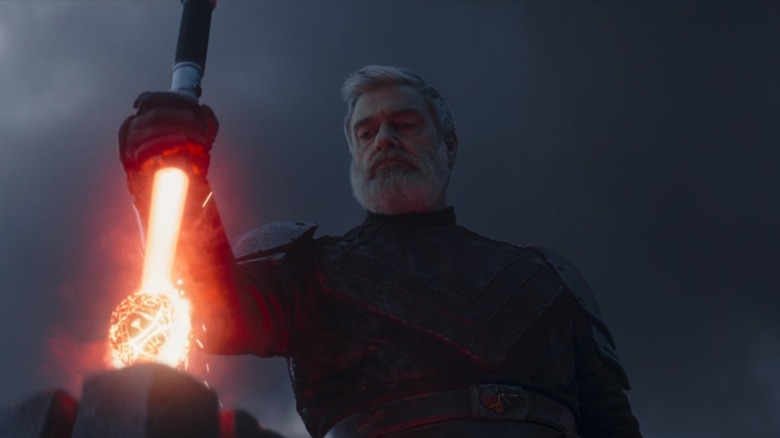Ahsoka Theory: Baylan Skoll Isn't A Sith - He's The Dark Knight The Jedi Need
Despite being the de facto villain of "Ahsoka," Baylan Skoll (the late Ray Stevenson) is one of the most engaging characters on the entire series. A Dark Jedi who turned to mercenary work after surviving Order 66, Skoll has spent the majority of "Ahsoka" attempting to obtain a map that will lead him and his allies to Grand Admiral Thrawn (Lars Mikkelsen) — who is famously thrown into another galaxy at the end of "Star Wars: Rebels." While it's easy to think of Skoll as yet another Jedi fallen to the dark side, his comments in "Ahsoka" Episode 4 make it seem like he plans to use Thrawn as a necessary evil — and that he ultimately believes he is helping the galaxy maintain order.
"The only reason I'm here is to secure the future," Skoll says prior to his duel with Ahsoka Tano (Rosario Dawson). "It is an unfortunate evil, but speaks to a greater truth. One must destroy in order to create." These comments make it clear that Skoll plans to use Thrawn's war for the "greater good" of the galaxy and imply that this Dark Jedi is playing a much larger game than we initially believed. Though we don't know the extent of Skoll's plan thus far, it seems like he intends to use Thrawn to establish peace across the galaxy — something Ahsoka and the rest of the Jedi Order never accomplished with their inaction and black-and-white worldview.
The Jedi Order failed spectacularly, and Skoll has learned from its mistakes
Given what we know about the aftermath of "Star Wars: Episode VI – Return of the Jedi," in which the New Republic's inaction leads to the rise of the tyrannical First Order, there's no question that a shrewd character like Baylan Skoll would have been very helpful in keeping the galaxy at peace. Unlike most of his Jedi counterparts, Skoll demonstrates the remarkable ability to look beyond the dark and light sides of the Force, at one point even taunting Ahsoka about the legacy of "death and destruction" she has created in service to the Jedi Order. Perhaps this explains his orange lightsaber — bordering between the light and dark sides of the Force — as he follows a new path to avoid the colossal failure that the Order left behind.
It's also worth mentioning that Skoll demonstrates a great deal of affection for a "Star Wars" villain, flying into a rage after Ahsoka Force pushes his apprentice, Shin Hati (Ivanna Sakhno), into a boulder. While most Jedi or Sith fall on one extreme of the spectrum of good and evil (particularly because so-called Gray Jedi don't actually exist in "Star Wars" canon), Baylan Skoll demonstrates a palpable desire for order but does not shy away from evil when it serves as a means to an end. In this, Skoll can be seen as the dark knight of "Star Wars," taking measures that most Jedi would consider abhorrent but that they needed to employ in order to create peace.

